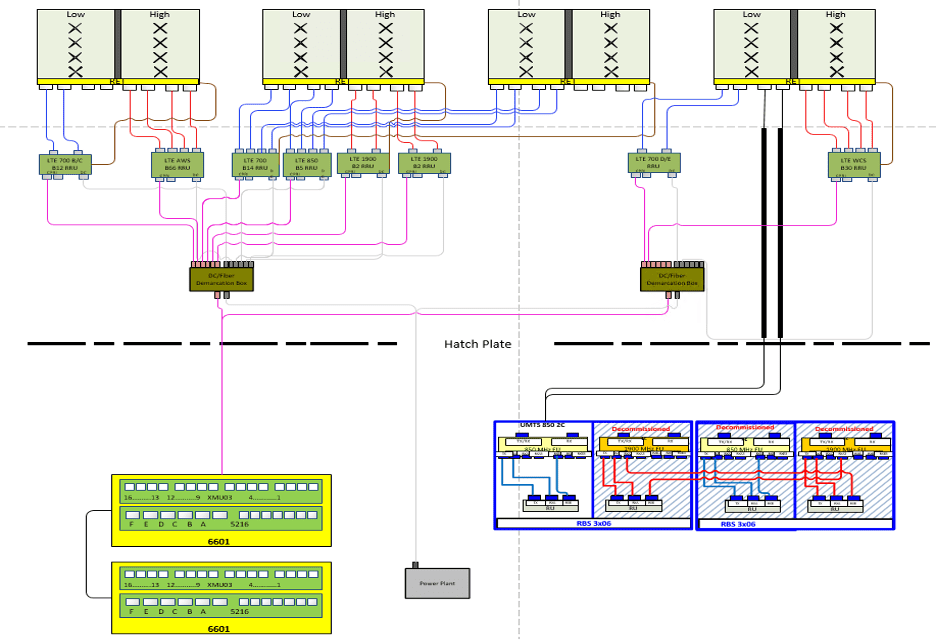Author: Tammy Hung
AI Meets Telecom: Automating RF Plumbing Diagrams at Scale
By Chode Balaji with Ajay Lotan Thakur
In radio frequency (RF) circuit design, an RF plumbing diagram is a visual representation of how components such as antennas, amplifiers, filters, and cables are physically interconnected to manage RF signal flow across a network node. Unlike logical or schematic diagrams, these diagrams emphasize signal routing, cable paths, and component connectivity, ensuring spectrum compliance and accurate transmission behavior.
In this article, I introduce an AI-powered automation platform designed to generate RF plumbing diagrams for complex telecom deployments, which dramatically reduces manual effort and engineering errors. The system has been field-tested within a major telecom provider’s RF design workflow, showing measurable reduction in design time and increased compliance, where it has cut design time from hours to minutes while standardizing outputs across markets. We discuss the architecture of the platform, its real-world use cases, and the broader implications for network scalability and compliance in next-generation RF deployments.
Introduction
In RF circuit and system design, an RF plumbing diagram is a critical visual blueprint that shows how physical components—antennas, cables, combiners, duplexers, and power sources—are interconnected to manage signal flow across a network node. Unlike logical network schematics, these diagrams emphasize actual deployment wiring, routing, and interconnection details across multiple frequency bands and sectors.
As networks become increasingly dense and distributed, especially with 5G and Open RAN architectures, RF plumbing diagrams have grown in both complexity and importance. Yet across the industry, they are still predominantly created using manual methods—introducing inconsistency, delay, and high operational cost [1].
Challenges with Manual RF Documentation
Creating RF plumbing diagrams manually demands deep subject matter expertise, detailed knowledge of hardware interconnections, and alignment with region-specific compliance standards. Each diagram can take hours to complete, and even minor errors—such as incorrect port mappings or misaligned frequency bands—can result in service degradation, failed field validations, or regulatory non-compliance. In some cases, incorrect diagrams have delayed spectrum audits or triggered failed E911 checks, which are critical in public safety contexts.
Compliance requirements often vary by country due to differences in spectrum licensing, environmental limits, and emergency services integration. For example, the U.S. mandates specific RF configuration standards for E911 systems [3], while European operators must align with ETSI guidelines [4].
According to industry discussions on automation in telecom operations [1], reducing manual overhead and standardizing documentation workflows is a key goal for next-generation network teams.
System Overview – AI Powered Diagram Generation
To streamline this process, we developed CERTA RFDS—a system that automates RF plumbing diagram generation using input configuration data. CERTA ingests band and sector mappings, node configurations, and passive element definitions, then applies business logic to render a complete, standards-aligned diagram.
The system is built as a cloud-native microservice and can be integrated into OSS workflows or CI/CD pipelines used by RF planning teams. Its modular engine outputs standardized SVG/PDFs and maintains design versioning aligned with audit requirements.
This system aligns with automation trends seen in AI-native telecom operations [1] and can scale to support edge-native deployments as part of broader infrastructure-as-code workflows.
Deployment and Public Availability
The CERTA RFDS system has been internally validated within major telecom design teams and is now available publicly for industry adoption. It has demonstrated consistent savings in engineering time—reducing diagram effort from 2–4 hours to under 5 minutes per node—while improving compliance through template consistency. These results and the underlying platform were presented at the IEEE International Conference on Emerging and Advanced Information Systems (EEAIS) [5]. (Note – Paper is presented at EEAIS 2025; publication pending)
Output Showcase and Engineering Impact
Below is a sample RF plumbing diagram generated by the CERTA platform for a complex LTE and UMTS multi-sector node. The system automatically determines feed paths, port mappings, and labeling conventions based on configuration metadata.
As 5G networks continue to roll out globally, RF plumbing diagrams are becoming even more complex due to increased densification, the use of small cells, and the incorporation of mmWave technologies. The AI-driven automation framework we developed is fully adaptable to 5G architecture. It supports configuration planning for high-frequency spectrum bands, MIMO antenna arrangements, and ensures that E911 and regulatory compliance standards are maintained even in ultra-dense urban deployments. This makes the system a valuable asset in accelerating the design and validation processes for next generation 5G infrastructure.
 Figure 1. AI-Generated RF Plumbing Diagram from CERTA RFDS: Illustrating dual-feed, multi-sector layout for LTE and UMTS deployment.
Figure 1. AI-Generated RF Plumbing Diagram from CERTA RFDS: Illustrating dual-feed, multi-sector layout for LTE and UMTS deployment.
Benefits include:
- 90%+ time savings per node
- Consistency across regions and engineering teams
- Simplified field validation and compliance review
Future Scope
CERTA RFDS is being extended to support:
- GIS visualization of RF components with geo-tagged layouts
- Integration with planning systems for real-time topology generation
- LLM-based auto-summary of node-level changes for audit documentation
Conclusion
RF plumbing diagrams are fundamental to reliable telecom deployment and compliance. By shifting from manual workflows to intelligent automation, systems like CERTA RFDS enable engineers and operators to scale with confidence, consistency, and speed—meeting the challenges of modern wireless networks.
Abbreviation
- CERTA RFDS – Cognitive Engineering for Rapid RFDS Transformation & Automation
- RFDS – Radio Frequency Data Sheet
- GIS – Geographic Information System
- LLM – Large Language Model
- OSS – Operations Support System
- MIMO – Multiple Input Multiple Output
- RF – Radio Frequency
Reference
[1] ZTE’s Vision for AI-Native Infrastructure and AI-Powered Operations
[5] IEEE EEAIS 2025 Conference, “CERTA RFDS: Automating RF Plumbing Diagrams at Scale,”
About Author
Balaji Chode is an AI Solutions Architect at UBTUS, where he leads telecom automation initiatives including the design and deployment of CERTA RFDS. He has contributed to large-scale design and automation platforms across telecom and public safety, authored multiple peer-reviewed articles, and filed several patents.
“The author acknowledges the use of AI-assisted tools for language refinement and formatting”


